This post may contain affiliate links. Please see our disclosure policy.
This traditional Korean cubed radish kimchi recipe, or kkakdugi in Korean, is easier to make than cabbage kimchi, and it’s ready to eat in just a day or two. It’s naturally paleo, Whole30, and keto, and you can easily make it vegan as well!

What is Kkakdugi?
Besides the most well-known napa cabbage kimchi, there are many kimchi varieties in Korea. Among all of them, kkakdugi is one of my favorites. Kkakdugi is a traditional Korean side dish made from cubed radishes called moo. If you can’t find moo, you can use daikon radish instead.
Kkakdugi is known for its crunchy texture and refreshing, slightly spicy, and tangy flavor. It’s refreshing and way easier to make than traditional kimchi.
Watch a Quick Recipe Video
Subscribe to my YouTube channel for more cooking videos and other fun tutorials!
Why You’ll Love This Recipe
This Kkakdugi Recipe is naturally paleo, Whole30, and keto, and you can easily adapt it to make it vegan-friendly as well. This delicious kimchi is served as a side dish, just like regular kimchi, and is most commonly eaten with rice.
The fermentation process is pretty quick, and it lasts for months in the refrigerator, making the perfect condiment or side to so many Korean dishes, from savory beef to soups, noodles, and more!
Ingredient Notes
Although attempting homemade kimchi feels intimidating, the kkakdugi recipe’s ingredients are quite simple and easy to find.

- Korean radish or “moo”: If you are unable to find Korean radish, you can use daikon radish with the same results. They are very similar in flavor and texture. Check your local ethnic market for moo, but I’ve often seen daikon radish at regular grocery stores these days.
- Sea salt: I used fine sea salt, but if you are using coarse sea salt, make sure to add more.
- Garlic: All Korean kimchi is heavy on garlic, and you can’t make kimchi without it.
- Ginger: Another important flavor in this Korean radish kimchi recipe. It’s subtle but necessary!
- Green onions: Some people cut these into larger pieces, but I like to chop them small so they are incorporated evenly into the kimchi.
- Gochugaru: This is Korean red pepper flakes used in a majority of Korean dishes. If you can’t find it locally, you can order it online. Make sure to use coarse flakes.
- Fish sauce: Many fish sauce brands on the market have additives you might want to avoid. I really love the Red Boat brand for the highest quality and flavor, and it’s also paleo and Whole30-friendly.
If you are making vegan kimchi, you can substitute fish sauce for tamari sauce or soy sauce (if you are okay with gluten).
Equipment
- Plastic disposable gloves: I highly recommend these to mix the kimchi ingredients with your hands. The spices of the kimchi, especially gochugaru, can be very strong and stay on your hands for a long time. You’ll also feel a tingly sensation on your hands if you don’t use gloves, and it’s not a pleasant feeling.
- Airtight glass jar: This kkakdugi recipe will yield about 8 cups, so I ferment it in a 64-oz jar like this one. However, if you only have smaller containers, you can divide the kkakdugi into multiple jars as well.
How to Make This Kkakdugi Recipe
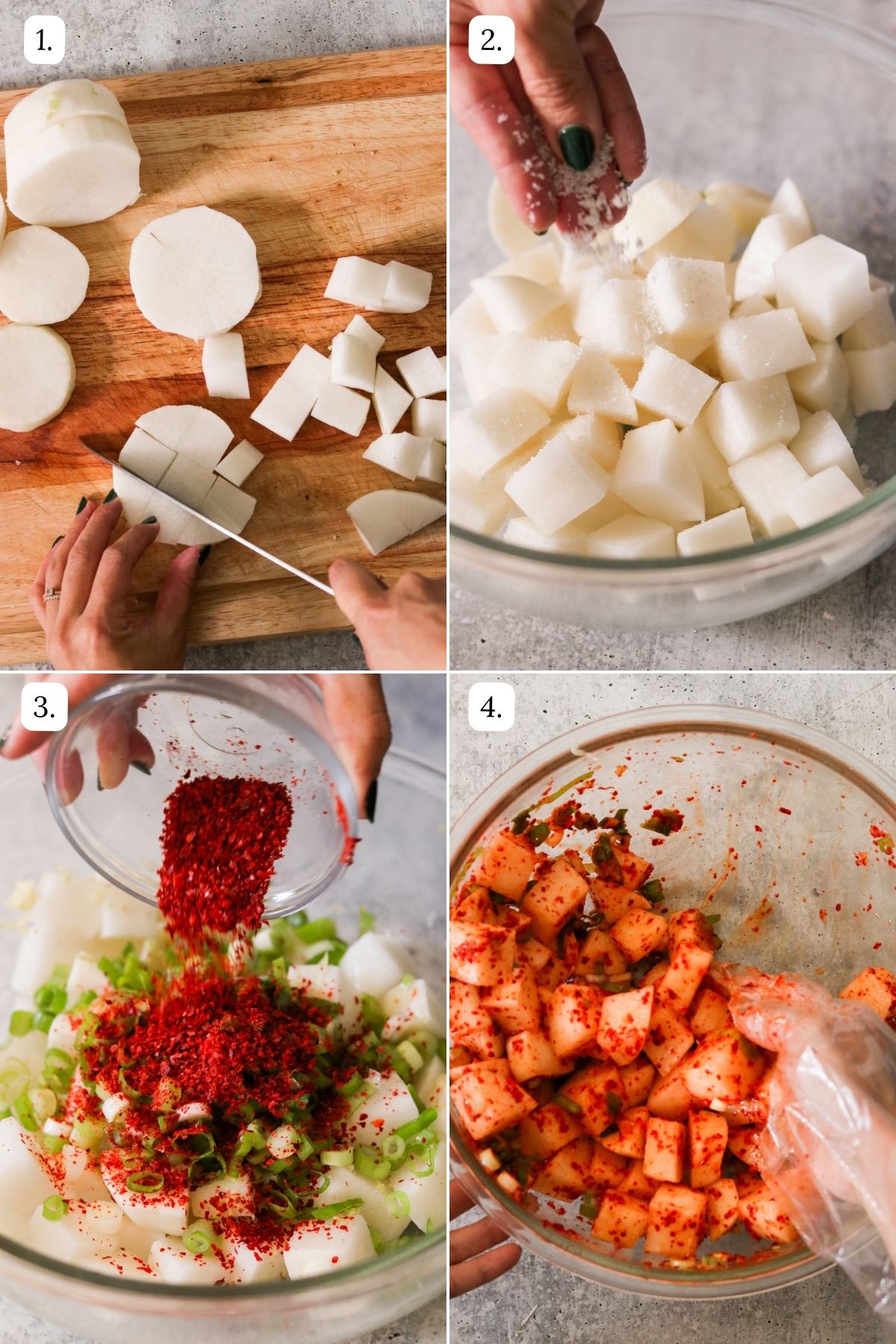
Step 1: Rinse the radish and peel. Cut the radish into bite-sized 1-inch cubes and put them in a large mixing bowl.
Step 2: Sprinkle with sea salt and toss together to coat. Let this rest for 30 minutes so the radish can sweat out its juice and soften. Drain out the juice.
Step 3: I highly recommend you wear plastic gloves before this step. Add the garlic, ginger, green onions, gochugaru, and fish sauce to the large bowl. Mix everything well with your hands so the spices are evenly coated.
Step 4: Taste to add more gochugaru or fish sauce, if needed. Keep in mind that the kimchi will get saltier as it ferments.
Step 5: Transfer to a glass jar with an airtight lid, pressing down firmly with your hand as you pour it in so the mixture is compact in the jar and there are no air bubbles. Ensure the top of the kimchi is at least 2 inches below the jar’s opening.
Step 6: Close the lid and let it sit at room temperature out of sunlight for 24 to 48 hours while it ferments. Check after 24 hours.
Step 7: It’s ready when you open the lid, and you see small bubbles escaping off the top, and the kkakdugi has a strong, sour smell. You can also taste it to check to see that it has fermented to your liking.
Step 8: Store your kkakdugi in the refrigerator and eat it with everything! It will keep well for longer than a year, but you may want to eat it within 3 to 4 months before it gets too sour.
Expert Tips
- Adjusting to Taste: What’s wonderful about Korean radish kimchi (or any kind of kimchi) is that the flavors will vary widely depending on who makes it. Every household has its own flavor, additions, and version that it makes.
- This Whole30 kimchi is not too spicy nor too salty. I created a Goldilocks version to please all taste buds, but you can add more gochugaru to make it more spicy or fish sauce for a saltier flavor.
- Also, I like my kimchi very sour and fermented, so I like to let this Korean radish kimchi ferment for the full 2 days. However, not everyone likes it that sour, and if that’s the case for you, you can ferment it for just 1 day. It really depends on how you like it!
Serving Tips
Serving kkakdugi is really up to you! It is typically served as a side dish or condiment and goes well with various dishes. Here are some suggestions:
Side Dish: Serve as a side dish or banchan (small side dish) alongside your favorite Korean main dishes.
Rice: Kkakdugi pairs wonderfully with a side of steamed white rice.
Soup: Add to Korean soups for an extra kick of flavor.
Barbecue: Serve it alongside this Pork Bulgogi or these Korean Steak Bites.
Noodles: Use it as a topping for Korean cold noodle dishes.
Sandwiches: Get creative and use it as a spicy and tangy filling for tacos, wraps, or sandwiches.
Storage Tips
Just like regular kimchi and many other fermented foods, this kkakdugi will last indefinitely in the refrigerator.
However, it’ll still continuously ferment slowly while chilling, so you may want to eat it within 3-4 months of making it. Otherwise, the flavor may get too sour for you to enjoy.

Recipe FAQs
7 simple ingredients: cubed radishes (moo), salt, garlic cloves, ginger, green onions, gochugaru, and fish sauce.
I like my kimchi very sour and fermented, so I like to let this Korean radish kimchi ferment for the full 2 days. However, not everyone likes it that sour, and if that’s the case for you, you can ferment it for just 1 day. It really depends on how you like it!
You’ll see sugar as one of the ingredients in many store-bought kimchi; some use it in their homemade kimchi as well. However, I have found that there are plenty of natural sugars in the radish to allow the kimchi to ferment properly. If you like your kimchi on the sweeter side, add some sugar for additional sweetness before mixing the ingredients.
However, if you are trying to make a keto and Whole30 kimchi, I recommend you leave out any added sweetener to keep it compliant.
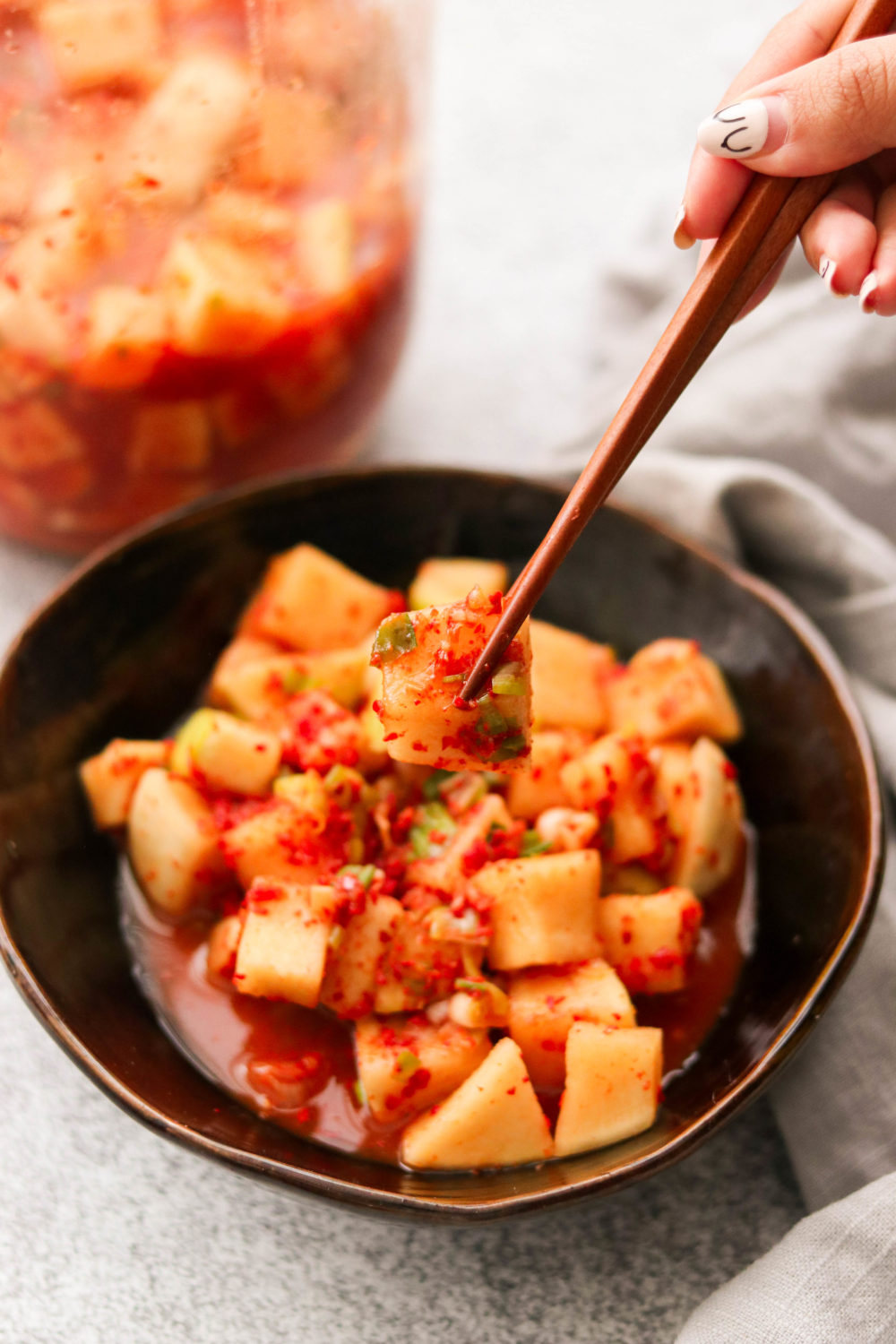
More Korean Recipes
Essential Ingredients for Korean Paleo Cooking
Kimchi Braised Keto & Whole30 Pork Ribs (Dweji Galbi Kimchi Jjim)
If you make this recipe, please leave me a star rating and comment below! I love to hear your thoughts and feedback. Follow me on social media Instagram, Facebook, and Pinterest for even more delicious recipes!

Easy Kkakdugi Recipe (Korean Radish Kimchi)
Video
Equipment
- Plastic gloves
- 64 oz jar (or use multiple smaller jars)
Ingredients
- 3 lb Korean radish, or daikon radish
- 4 tsp sea salt
- 5 cloves garlic, minced
- 1 inch fresh ginger, grated
- 4 stalks green onions, chopped
- 1/3 cup gochugaru, Korean red pepper flakes
- 1/4 cup fish sauce, or tamari sauce for vegan
- OPTIONAL : 1-2 tbsp sugar, omit for Whole30 or keto
Instructions
- Rinse the radish and peel. Cut the radish into bite-sized cubes and put them in a large mixing bowl.
- Sprinkle with sea salt and toss together to coat. Let this rest for 30 minutes so the radish can sweat out its juice and soften. Drain out the juice.
- I highly recommend you wear plastic gloves before this step: Add the garlic, ginger, green onions, gochugaru, and fish sauce. Add sugar if you wish. Mix everything well with your hands so the spices are evenly coated.
- Taste to add more gochugaru or fish sauce, if needed. Keep it mind that the kimchi will get saltier as it ferments.
- Transfer to a glass jar with an airtight lid, pressing down firmly with your hand as you pour it in so the mixture is compact in the jar and there are no air bubbles. Make sure the top of the kimchi is at least 2 inches below the opening of the jar.
- Close the lid and let it sit at room temperature out of sunlight for 24 to 48 hours while it ferments. Check after 24 hours.
- It's ready when you open the lid and you see small bubbles escaping off the top and the kkakdugi has a strong, sour smell. You can also taste to check to see that it has fermented to your liking.
- Store your kkakdugi in the refrigerator and eat it with everything! It will keep well for longer than a year, but you may want to eat it within 3 to 4 months before it gets too sour.
Notes
Expert Tips
- Adjusting to Taste: What’s wonderful about Korean radish kimchi (or any kind of kimchi) is that the flavors will vary widely depending on who makes it. Every household has its own flavor, additions, and version that it makes.
- This Whole30 kimchi is not too spicy nor too salty. I created a Goldilocks version to please all taste buds, but you can add more gochugaru to make it more spicy or fish sauce for a saltier flavor.
- Also, I like my kimchi very sour and fermented, so I like to let this Korean radish kimchi ferment for the full 2 days. However, not everyone likes it that sour, and if that’s the case for you, you can ferment it for just 1 day. It really depends on how you like it!
Serving Tips
Serving kkakdugi is really up to you! It is typically served as a side dish or condiment and goes well with various dishes. Here are some suggestions: Side Dish: Serve as a side dish or banchan (small side dish) alongside your favorite Korean main dishes. Rice: It pairs wonderfully with a side of steamed white rice. Soup: Add to Korean soups for an extra kick of flavor. Barbecue: Serve it alongside this Pork Bulgogi or these Korean Steak Bites. Noodles: Use it as a topping for Korean cold noodle dishes. Sandwiches: Get creative and use it as a spicy and tangy filling for tacos, wraps, or sandwiches.Storage Tips
Just like regular kimchi and many other fermented foods, this Korean radish kimchi (kkakdugi) will last indefinitely in the refrigerator. However, it’ll still continuously ferment slowly while chilling, so you may want to eat it within 3-4 months of making it. Otherwise, the flavor may get too sour for you to enjoy.Nutrition
Nutrition information is automatically calculated, so should only be used as an approximation.
Regarding other affiliate links and affiliate relationships: In order for me to support my blogging activities, I may receive monetary compensation or other types of remuneration for my endorsement, recommendation, testimonial and/or link to any products or services from this blog. Thank you for your support and understanding.


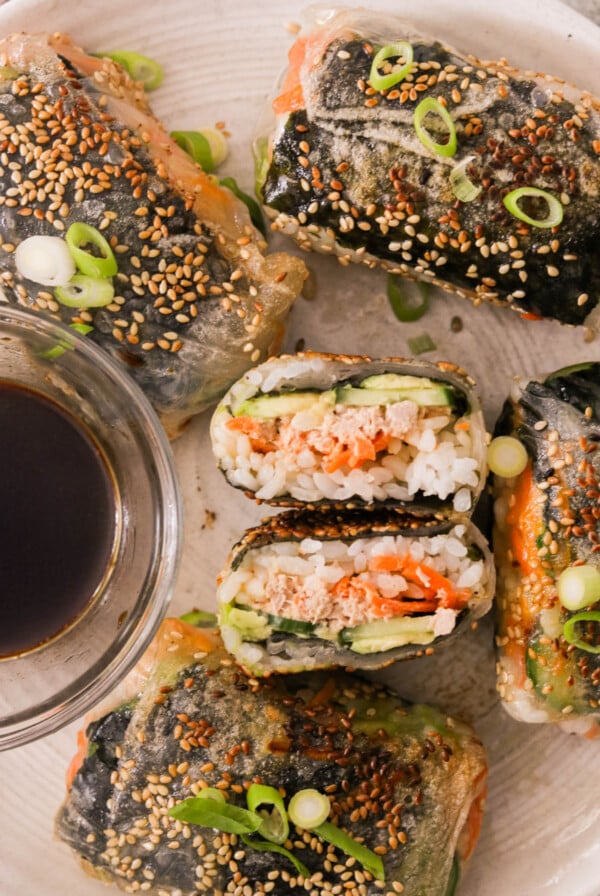
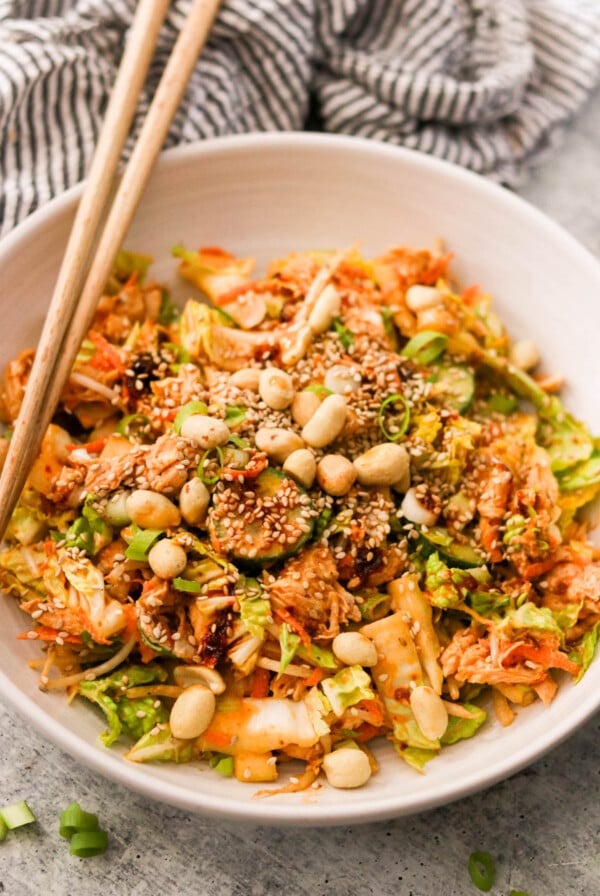
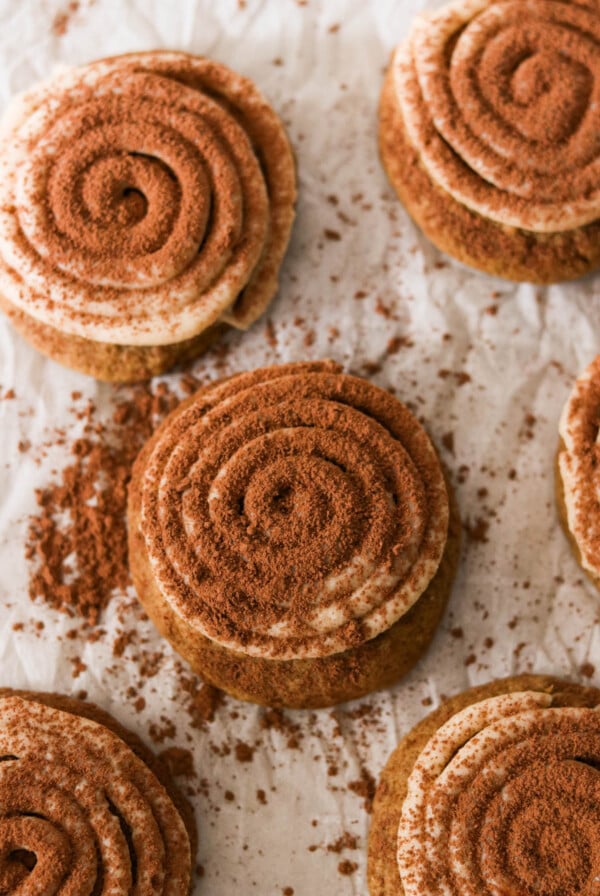
Do I have to ferment the kimchi? Can I just put it in the fridge in an airtight container?
You don’t have to. It’ll ferment much slowly in the refrigerator. You can eat it unfermented but it’ll be a bit bitter and not as flavorful.
My husband loves radishes I can’t wait to make this for him
Getting ready to try this recipe again. The batch I made in early summer with turnips turned out good and was a hit with everyone who tried it. I just harvested a bunch of icicle radishes from my garden. I am going to follow this recipe using them and I am also going to add some fresh radish greens and sliced red pepper. I will let you know what happens.
Sounds delicious. Hope it turns out well!!
It turned out great! I did not have quite enough of the icicle radishes to get the full three pounds needed, so I washed (twice, thoroughly) a bunch of the leftover radish greens, chopped them up fine, and added them to the mix. I also had a few sweet red peppers on hand and chopped them up and added them too. Turned out great. Everyone who tried it liked it. I thought the greens gave it a nice extra added flavor, and the peppers went well with it too. Wish I could attach a picture.
Could I use a pear or apple to sweeten this? I know asian pear is used in cabbage kimchi.
Yes – that’ll work fine!
This looks like a good recipe and I am going to give it a try. How do you think it would turn out to use turnips in place of radishes? I have a lot of them in my garden and am looking for something to do with them.
I’ve never tried! It’s not used in traditional kimchi. I think it would work though!
Recipe was very easy to follow. Thank you so much for sharing this. I went to a local Asian market and got all the ingredients I needed. Noticed they had the Korean radishes so I picked up a little over three pounds of those too. Made two batches: one following your recipe to the T using the Korean radishes, and a second batch that used the little bit of Korean Radish that was left, then about a pound and a half of regular purple top white globe turnips from my garden, and I made up the remainder with carrots and white radishes (also from my garden). I let it ferment in a dark cabinet at room temperature in 1 pint mason jars for two days. Ended up with 8 pints all together. Checked them this morning and all were fermenting and bubbling nicely. Rotated them into my fridge and will give them a couple of weeks to age. I did sample them. The Korean radish batch tasted excellent. As for the other batch, the turnips tasted good but I sampled a piece of the white radish and it was a tad bitter. However, I expect the flavor to improve and I expect to flavor of the carrots and turnips to offset the bitterness of the white radishes. I will let you know how it turns out but I am pretty confident both batches will be great. I posted a short video of the fermentation on Facebook. Thought it was pretty cool. Now to start work on this year’s batch of homemade wine….
Link to the video. https://www.facebook.com/dan.stewart.528/videos/10217769081080715
So glad you liked it! And I love experimenting with recipes like that. I bet the carrots taste wonderful in there!
I have kept it in the fridge for the last two weeks and tried some today. The flavor has really sunk in well. The kimchi made with ordinary purple top turnips tasted very similar to the kimchi I made with only mu radish. Both turned out great. The batch with the turnips also had some American white radish and carrots in it. The carrots tasted great and the white radish was not bad, but some people might find it a tad strong. I am going to make another batch today using only purple top turnips. Quick question, I noticed when opening them yesterday that they were still fermenting after two weeks in the fridge. Is that normal?
That’s great! So glad they turned out well. Yes, it’s completely normal for kimchi to continuously ferment in the fridge. The fermentation process is much slower than at room temperature, but it keeps going. Hope you enjoy!!
I grow my own cayenne peppers and grind them. I’m wondering what the taste difference is between those and the Korean red pepper flakes would be. Any idea? Also, what would you say is the heat factor of this dish?
Thank you!
You really can’t make authentic kimchi without the Korean pepper flakes or ground pepper called gochugaru (spelled a variety of different ways in English). But if you don’t have prior experience with authentic Korean kimchi, then it might not matter to you.
I just never cared for what I could find in jars after I left the DC/NoVA area where there’s a sizeable Korean population, so I decided to make my own and ordered a bag of the ground Korean pepper online. It’s wasn’t that expensive and it’s going to last me quite some time.
As to how hot it is, that is such a judgment call that it’s almost impossible for anyone to answer that question. I will tell you that I start with less gochugaru (half or less?) than called for in any recipe by someone who is Korean, and then add more if it’s not hot enough for me. Try imagining how much that would be if it was a pepper you’re more familiar with like cayenne. That’s a good approach for any spicy cuisine. I do the same with Indian recipes.
The bottom line is that you can always add more, but you can’t take it out after you put it in!
Hi Amy. I find Gochugaru is almost a sweet bell pepper with a small amount of heat. Cayenne, while very sweet in raw form, really can’t be added in its dry form to a level the sweetness stands out without increasing the heat to where that dominates. Gochugaru is sweet as primary profile with a tiny amount of heat. The color is unparalleled. While I might substitute cayenne, be prepared for a different flavor profile. I might add cayenne in addition to Gochugaru to make it hotter. I like HOT.